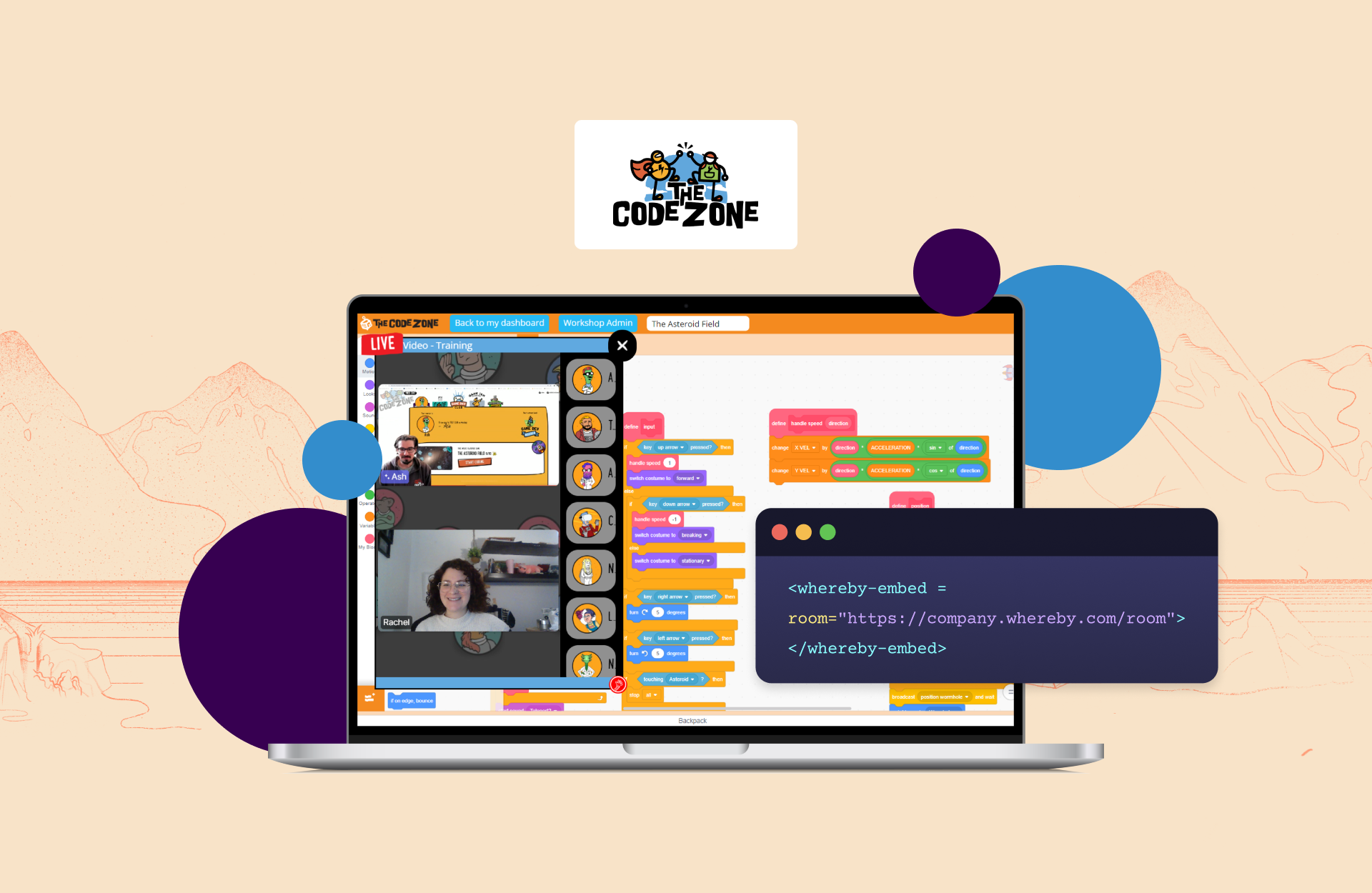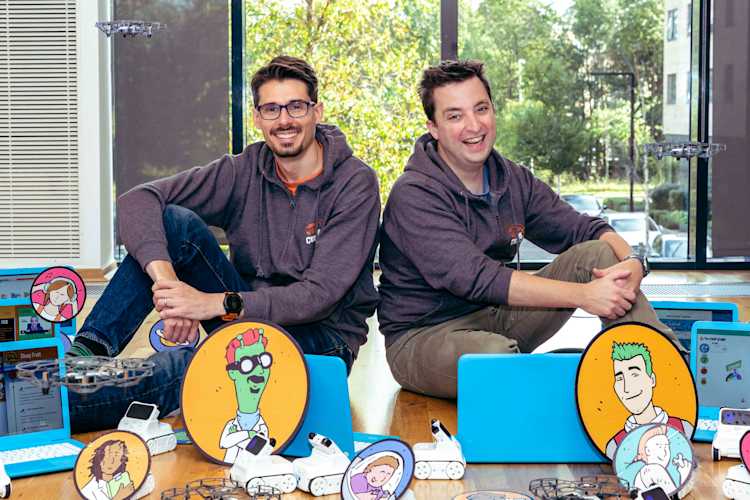Engaging the Future: Why a Kids Coding Club Swapped Twilio for Whereby
We caught up with CTO Paul Allington to find out more about their exciting platform and how using Whereby’s technology has significantly improved their offering for students.

The Code Zone has one mission: to make coding fun and accessible for children. What started as a small coding club for a local school has grown into a global network of coding educators and students, learning virtually by building games with their “Game Dev Club”. We caught up with CTO Paul Allington to find out more about their exciting platform and how using Whereby’s technology has significantly improved their offering for students.
From flying drones in playgrounds to building games online
In 2019, Paul started running a small coding club for his local school in Essex, England. He used drones and robots to make coding exciting for children and encourage them to want to learn more about technology and the wonderful world of coding. It worked! Soon Paul, along with his business partner and CEO, Ashley, were running five successful clubs in the area. When the COVID-19 pandemic hit in 2020 and schools closed down, a quick decision was made to take the classes online. The lockdown forced their hand on an idea that had been bubbling and pushed them over the line to kick off their online offering.
“It was hard work and it was a lot of change to move things online. We made plenty of mistakes along the way, but now we run these very successfully”
Since going virtual, The Code Zone has grown rapidly with a team of almost 30 people and classes running for students across the UK, US and Europe. Through their “Game Dev Club”, students are provided with a guided task to work through with their mentor to build fun, interactive games. The business grew 275% in 2023, with children creating over 6000 games and is set to continue to grow into 2024.

Video solutions; the good, the bad, and the ugly
Running virtual classes required a video call solution the moment The Code Zone moved online, but choosing the right solution was no simple task. In the very early days, lessons were run on Zoom, but it quickly became apparent that an integrated solution, embedded directly into their platform was needed.
”We work with a lot of 6, 7, 8 year olds, some have never used a computer before and now they're having to jump between two tabs or applications and that became really complicated and they got very frustrated.”
Paul began testing different solutions, looking at around 50 different options initially before settling on Twilio. Their chosen solution needed to be capable of mentors remotely accessing a students screen within a browser, as well as trying where possible to keep costs to a minimum for the growing business. The level of integration and customization available with Twilio was attractive, but it soon turned out to be incredibly problematic and cumbersome to update and maintain.
“There were a number of different issues that we had'', says Paul, “it's a very JavaScript-heavy integration and we used Blazor, which is not based on JavaScript. This was possible to overcome, but we had to build absolutely everything—every part of that system in terms of how we got the children in, the security around it, turning things on and off, where we even placed the videos.”
“We're mainly developers, so this isn't hard for us, it's just time consuming.”
They also found that many of their young students were working on very old or out-of-date hardware resulting in JavaScript and audio feedback issues, as well as complications in permission settings. The team attempted to get support from Twilio but to no avail, so they decided to start looking at alternative solutions.
Migrating to Whereby in one morning
Following one particularly bad evening of technical issues with Twilio, Paul decided to make the jump to Whereby, having learned about the API solution from previous research. The following morning, Paul got started switching to Whereby, and in just 2 hours had an MVP solution up and running, just in time for the afternoon’s classes.
“I think it took me about two hours and we had everything up and running by the afternoon clubs. There was still tweaking required, but we had the video running and that’s what was important.”
The initial set up to switch Twilio to Whereby in their existing UI was incredibly simple, allowing for a seamless transition and no downtime for their daily classes. This allowed everything to continue, uninterrupted, while the team continued to improve and build on the integration to create an even better, seamless experience. They added further customization, removed built-in Whereby features that weren’t required such as chat, and integrated Whereby into their lobby system for easy access.

While there were cheaper solutions available, the quality, reliability and ease of customization with Whereby were a no-brainer.
“We decided that the difference between doing it ourselves and having someone else take all of those problems on was worth it, which is why we ended up switching and in the end it all worked out very well. We came to the conclusion that balancing cost versus quality was important” says Paul.
Building into the future
With Whereby up and running, Paul and his team continue to develop and improve their video call offering using new features, as well as digging deeper into the capabilities of the Whereby API and SDK. With a growing number of mentors and classes across the globe, security is ever important, so The Code Zone are making use of capabilities such as programmatic room creation to ensure meeting rooms are only created when needed when the coding sessions start. They are also using cloud recording for safeguarding, without the need to rely on mentors to record manually or upload a recording. This gives parents added peace of mind that The Code Zone is ensuring safe learning environments for their children.
Issues surrounding older devices still crop up, but through collaborative feedback with the Whereby Solutions team, and troubleshooting work-arounds, the experience is continuing to improve. “Obviously the quality is much better now, the compatibility with the children’s devices has been a lot better.” states Paul.
Unlike with Twilio, Paul and his team feel supported by Whereby through our collaborative and responsive approach. “Support has been amazing and having someone very responsive and very accustomed to us, helping us through any challenges that we have had has been great.”
Pre-built features for better engagement
The ability to switch off and on different features has been highly beneficial for The Code Zone to create the best possible experience for students.
“You'll laugh at this, but one of the main features we use is the ability to lower children’s volume.” says Paul. The ability to turn individual students' volume up and down locally has been highly beneficial. Not only for the mentor, with the ability to make louder children a bit quieter and enabling them to give equal attention to all students, but also for the students themselves.
“Sometimes you have a child who is neurodivergent or is just loud and likes to talk. So we don't mind being able to hear them, but it can be disturbing to the children. So we encourage them to use the volume slider so they can just turn all of the other children off so they don't have to hear any of them and can just focus.”
This allows for better concentration and learning for the students as well as enabling a more one-to-one coaching relationship, even in a group learning environment.
The pre-call device test feature has minimized technical issues by encouraging students to check their microphone, camera and internet connection before joining the virtual classroom. It empowers them to check everything is working themselves, rather than the first few minutes of the session being taken up by helping with technical set up. The camera and microphone permissions functionality is also a lot simpler and easier to use compared to Twilio, further minimizing technical blockers to begin virtual sessions.

A solution that “just works”
The Code Zone team have found the ease of use and integration of Whereby refreshing and uncomplicated.
“It’s a very straightforward piece of video software, which is what you want it to be. I think that's it for us, the key is: it just works.”
The ability to get started with an MVP incredibly quickly, and then build and expand on the capabilities over time, has allowed The Code Zone to continue running effective lessons, while improving performance and engagement incrementally.
We’re excited to see what the future holds as they continue to dig into the capabilities of Whereby’s API and SDK.
Switching from Twilio?
With Twilio’s programmable video solution sunsetting, now is the time to find the right solution for your integrated video needs. We’re here to help you to migrate with ease, check out our migration guide or get in touch to find out more.


